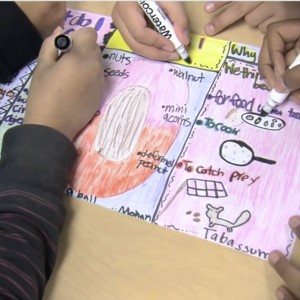“Shhh…It’s a secret! … We’re thinking. There’s so much learning but you don’t realize it. The teachers help us but students do most of the thinking. Sometimes, we think so much that our heads hurt. We are the ones doing the projects and teachers guide us through the hard work but they don’t tell us the answers” (Madison, 2014, para. 4). Madison, a fourth grade student from Michigan, is expressing what thousands of student are declaring nationwide, “PLEASE LET ME LEARN THROUGH SOMETHING I REALLY CARE ABOUT!” Teachers have long recognized that the more interest a student has in what he/she is doing, the more motivated they are to learn. One of the best ways to maximize engagement and motivate  your students is through Project Based Learning (PBL).
your students is through Project Based Learning (PBL).
PBL has been around for years and with the introduction of new, more rigorous standards it is resurfacing in classrooms everywhere! This teaching method motivates students as they gain knowledge and skills by working through problems that are real and relevant. “PBL doesn’t ask you to replace your content. It asks that you create a vehicle in which to communicate your content” (Wolpert-Gawron, para. 21). Aligning project based teaching to Common Core Standards is more than just listing a bunch of standards like so many traditional resources do. Teachers have to plan projects that align with grade level standards beginning with a driving question. That question leads to collaborative tasks that culminate with student produced products.
A well-designed project must be personally meaningful and fulfill an educational purpose. Determining the standards for what constitutes a good project should be carefully planned. Once that has been established the following criteria should be addressed:
- Relevancy or a need to know. LOOK around…relevancy is everywhere!
- Establish a driving question. It is like a thesis statement, the question is what drives the need to know. “The learning came from the questions. Did I mention I love questions? They push us farther than we expect to go. It makes us dig deeper into the unknown. The best part of asking questions is finding the answers” (Gaby, 2014, para. 5)
- Give your students voice and choice. IF you have to limit choice, make sure there is a menu of choices.
- Model the process. Demonstrate whatever process you want your students to follow preferably through other students.
- Facilitate collaboration. Task management is key to the success of the project. Students are able to do this at a very early age.
- Encourage If they have a plan to accomplish their goal; they should be allowed to go for it!
- Formalize Plan for and schedule feedback right from the onset of the project.
- Allow time for revision. Just like adults, students should be able to revise as needed.
- Allow choice for presenting a project with a focus on the audience.
- Celebrate! Take time to formally acknowledge your students’ accomplishments as they share their enthusiasm.
If you would like to learn more about the journey into the world of PBL, look no further than the Buck Institute for Education (BIE)! BIE is the premier resource for project based teaching and everything you need to get started is just a click away.
Please take a few minutes to reply and let me know what projects your students are working on or follow me on Twitter at: @cathtedesco44.
References
BIE. (n.d.). http://bie.org/about/what_pbl
Madison and Gaby. (November 20, 2014). Viewpoint on PBL: What Students Say [Blog post]. Retrieved from http://bie.org/blog/viewpoint_on_pbl_what_students_say
Wolpert-Gawron, H. (2015). What the Heck Is Project-Based Learning? Retrieved from http://www.edutopia.org/blog/what-heck-project-based-learning-heather-wolpert- gawron
No surprise that employers and colleges want to see students who’ve had the chance to do PBL projects – they promote critical thinking and problem solving! Great summary of what PBL should look like.
This paradigm shift, from traditional “sit and get” teaching methods to a more PBL approach, can be a challenge. The steps outlined here are a practical, concrete way for teachers to successfully incorporate this into their daily instructional practice. Wouldn’t it be great if every child, in every classroom, could experience this type of environment? The results might just our educational arena!
Great hook to get the reader interested in your topic. You give practical and clear steps to implement PBL. Students should all have the opportunity to learn in this type of environment.
That’s a smart way of lokoing at the world.